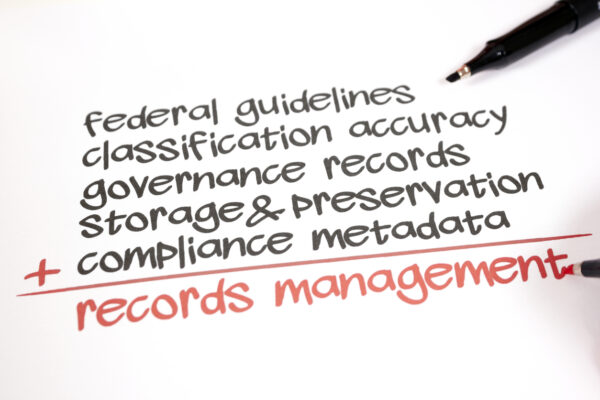If you hear M-19-21 and aren’t a federal records manager, chances are you may not be aware of the policy issued to help improve the efficiency and accuracy of government records through digitization.
M-19-21 is a federal directive issued for government agencies to completely transition away from hard copy records to digital records management systems by December 31, 2022. With only a few months left to achieve compliance before the end of the year deadline, federal agencies will need to take the appropriate steps now towards implementing successful digital conversion of their record management systems and business processes.
In order to achieve compliance with M-19-21, it’s important to understand the following:
- What is M-19-21?
- Who is impacted?
- When is the deadline?
- How will compliance be achieved?
In this blog, we’ll provide an overview to help answer these questions as well as some tips for creating a compliance plan.
What Is M-19-21?
M-19-21 is a government-wide policy that was jointly issued by the Office of Budget & Management (OMB) and the National Archives & Records Administration (NARA) which requires all business processes, recordkeeping methods, and document management systems to transition to an electronic format by the end of 2022. After the December deadline, NARA will no longer accept any paper documents/records.

Who Is Impacted
All federal agencies are impacted by M-19-21. Any government departments, corporations, and organizations that are branches of the federal government will have to achieve compliance by December 31, 2022.
What Does This Mean For Federal Agencies?
In order to improve accuracy, efficiency, and secure storage of government records, M-19-21 was created to help government agencies achieve better record management systems and implement best practices for digitization.
By the end of 2022, federal agencies must take the appropriate steps to convert their government record management systems including paper files, documents, and appropriate metadata into a digital format. It also mandates that by 2022 all federal records must be created, modified, and maintained electronically.
For information on M-19-21, see the Memorandum for Departments and Agencies.
Government Agency Responsibilities
Federal agencies need to achieve compliance in these key areas prior to the deadline. Here’s an overview of government agency responsibilities:
- All temporary records must be managed electronically.
- Federal agencies should manage all permanent electronic records in a digital format by 2019.
- All permanent federal records with appropriate metadata must be created and managed in an electronic format by 2022.
- Government agency-operated records storage facilities must be closed by 2022:
- They are responsible for transferring inactive, temporary files, and paper records to a Federal Records Center facility or a commercial storage facility by 2022.
- Federal agencies must maintain a record management program that is compliant with the Federal Records Act.

5 Tips For Successful Compliance: M-19-21
Whether you’re a federal agency or an organization who is transitioning from paper to digital document management, here are some tips for ensuring continued compliance and success with your digitization projects.
1/ Develop and implement a comprehensive digitization strategy for converting permanent records into a digital format. The plan should outline your scanning and record preservation processes, digital conversion methods, and steps that will be taken to ensure continued compliance.
2/ Utilize automated systems to accurately capture, organize, and securely store digital content/metadata. Ensure your digital document management systems have the proper tools and security features to efficiently manage your electronic records and metadata.
3/ Implement quality assurance processes and measures to ensure the integrity and preservation of digital records and data throughout their designated lifecycle period.
4/ Ensure digital record management and storage systems are all properly maintained and efficiently operating. Utilize secure hosting and cloud storage to protect sensitive information, records, and data.
5/ Implement a data migration policy/system to transfer documents and electronic records to NARA in accordance with compliance guidelines.
As federal agencies prepare for the M-19-21 deadline and implement digital conversion solutions, it’s important to have a plan in place with the necessary support systems and operational processes ready to go in order to be successful with the transition to digital records. If you’re looking for a partner to assist you with your scanning and digital conversion needs, remember to look for a vendor who has the right experience, credentials, and expertise to ensure your project is properly managed and compliant with relevant industry guidelines.
Next Steps
Reach out to us today! Click the “Get Your Quote” button below, fill out the form, and we’ll quickly reply to you to discuss your project.
Further Reading
Below are additional articles about secure digitization that may help you create your plan to comply with M-19-21.
“CJIS Digital Scanning” is our overview of how to go about scanning criminal justice information (CJI) for law enforcement agencies. As a member of a court, we’re almost certain that you and your colleagues are handling and processing CJI, so this should be a good starting point for you to understand what CJIS means and why it’s important to you.
“Choosing A Partner For Your Secure Scanning Project” discusses secure scanning and provides ideas on what to look for when you choose a scanning partner for your digital conversion project.
“Digitizing Court Records” provides information about the general benefits of digitizing court records, an overview of the digitization process, and services available for scanning court records.

